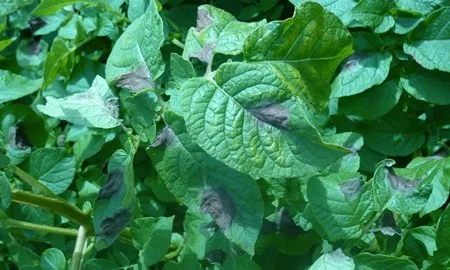
Confirmation of another strain with reduced sensitivity to fluazinam should serve as a reminder of immense capacity of the late blight pathogen, Phytophthora infestans, to evolve.
Author
| 9th June 2022Tags
Vigilance needed in battle with resistant blight strains
Growers will need to plan their strategy carefully if they are to respect resistance management guidelines while ensuring crops are effectively protected through to the end of the season. How growers achieve this in practice, has ramifications for tuber blight protection, so it may be easier to work backwards from haulm destruction rather than try to set out a programme beginning at emergence. The key point being to ensure the final three sprays of the programme are those with recognised good anti-sporulant activity.
In addition to 37_A2 which continues to be found at low levels – typically 7-8% of samples received for testing in 2021 – the emergence of 41_A2 in Fife, Scotland during 2021 underlines the need to practice good resistance management. Both strains demonstrate reduced sensitivity to fluazinam while 41_A2 has been found to be more aggressive than other strains on varieties considered resistant to late blight.
There are other developments too with the potential to set the 2022 season apart from earlier years.
The most significant development to affect blight strategies is the regionalisation of strains across Great Britain. That certain strains appear to dominate in one region but not another partly reflects how attitudes to crop protection vary across the country but also how local conditions can favour one strain over another.
Across England, late blight is dominated by 36_A2. In East Anglia it accounts for 60% of the samples submitted by blight scouts to the Euroblight survey during 2021.
This is significant because it has been found to be more aggressive and therefore more damaging to crops than the strains it has largely displaced such as 6_A1 (Pink 6) and 13_A2 (Blue 13). Programmes and intervals will need to reflect the greater threat 36_A2 poses.
In Scotland, growers face a more complex threat. There is a greater mix of strains. These will manifest differently according to the variety and crop situation, so crops will need to be inspected more regularly. The arrival of 41_A2 in Fife should focus attention. If this is as damaging as research suggests, growers will face a tough challenge.
The implications of this heightened pressure will be felt most acutely in the mid-season during the rapid canopy stage because of amount of new material that is unprotected between sprays. How growers and advisers, respond to this challenge will influence the strategy at the end of the season when the focus is tuber blight protection.
The loss of fast-acting desiccants means crops need tuber blight protection for longer as haulm destruction takes longer. The consequence of this is that the final three sprays of the season should deliver strong anti-sporulant activity to reduce the risk of tuber blight.
In practice, this requirement limits growers to two active substances, cyazofamid (as in Ranman Top®) and fluopicolide (as in Infinito®).
As Infinito® (propamocarb + fluopicolide) is the only product available that contains fluopicolide, it is an essential part of a tuber blight strategy. Cyazofamid is often applied between sprays of Infinito.
Fungicide sensitivity testing performed in 2021 as part of the Euroblight survey found no shifts in the efficacy of other modes of action beyond those already identified such as 13_A2 (Blue 13) to metalaxyl and 37_A2 to fluazinam.
Perhaps of some concern, however, was confirmation that UK isolates of 36_A2 have been found on Black nightshade (Solanum nigrum). This raises several concerns. First, Black nightshade is also an acknowledged host for Alternaria solani, the principal form of early blight. As the cultivation of this plant is promoted for the reduction in potato cyst nematode populations, it may make reducing sources of both Phytophthora infestans and Alternaria solani inoculum more difficult.
Second, Black nightshade is seen as a viable source of resistance genes for a new generation of blight-resistant cultivars as it never succumbs to late blight. Should these resistance mechanisms be broken down before they can be successfully stacked for use in commercial varieties, it would mean a continued reliance on fungicides. This further raises the need to practice good resistance management strategies while minimising sources of infection such as volunteers and those plants on dumps.